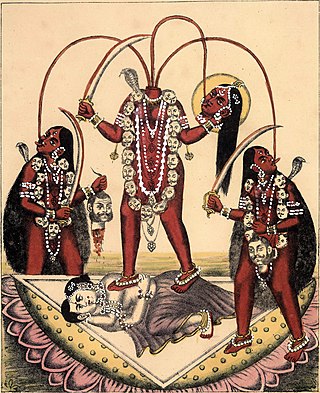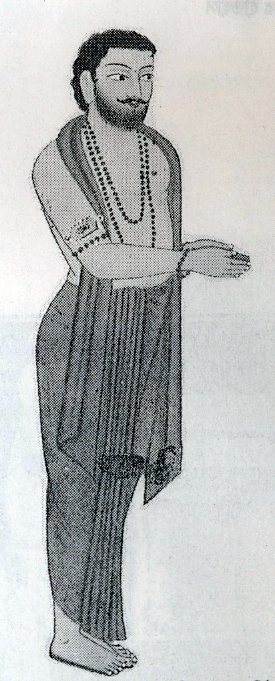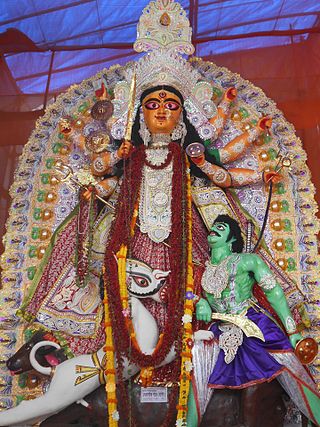Related Research Articles

Chhinnamasta, often spelled Chinnamasta, and also called Chhinnamastika and Prachanda Chandika and Jogani Maa, is a Hindu goddess (Devi). She is one of the Mahavidyas, ten goddesses from the esoteric tradition of Tantra, and a ferocious aspect of Mahadevi, the Hindu Mother goddess. The self-decapitated nude goddess, usually standing or seated on a divine copulating couple, holding her own severed head in one hand and a scimitar in another. Three jets of blood spurt out of her bleeding neck and are drunk by her severed head and two attendants.
Tantras in Hinduism are esoteric scriptures.

In the Shaivism and Shaktism tradition of Hinduism, the goddess Tara is the second of the ten Mahavidyas. She is considered a form of Adishakti, the tantric manifestation of Parvati. Her three most famous forms are Ekajaṭā, Ugratara, and Nīlasarasvatī. Her most famous centre of worship is the temple and the cremation ground of Tarapith in West Bengal, India.

Shaktism is one of the several major Hindu denominations wherein the metaphysical reality, or the godhead, is considered metaphorically to be a woman.

Dakshineswar Kali Temple or Dakshineswar Kalibari is a Hindu navaratna temple in Dakshineswar, Kolkata, West Bengal, India. Situated on the eastern bank of the Hooghly River, the presiding deity of the temple is Bhavatarini (Kali), a form of Mahadevi or Parashakti Adya Kali, otherwise known as Adishakti Kalika. The temple was built in 1855 by Rani Rashmoni, a Zamindar, philanthropist and a devotee of Kali Maa. The temple is known for its association with Ramakrishna and Ma Sarada Devi, mystics of 19th century Bengal.

Jagatdhatri or Jagaddhatri is an aspect of the Hindu goddess Durga, worshipped in the Indian state of West Bengal and other states like Odisha and Jharkhand. Jagaddhatri Puja is particularly famous in Chandannagar town of Hooghly district and Krishnanagar of Nadia district in West Bengal where it is celebrated as a five-day-long festival. Her worship and rituals are derived from Tantra. It is believed that her worship frees her devotees from ego and all other materialistic desires.

Rāmprasād Sen was a Hindu Shakta poet and saint of 18th-century Bengal. His bhakti poems, known as Ramprasadi, are still popular in Bengal—they are usually addressed to the Hindu goddess Kali and written in Bengali. Stories of Ramprasad's life typically include legends and myths mixed with biographical details.

Kalna or Ambika Kalna is a town in the Purba Bardhaman district of West Bengal, India. It is the headquarter of the Kalna subdivision, situated on the western bank of the Bhāgirathi river. The town is more popularly known as Ambika Kalna, named after the goddess Kali, Maa Ambika. It has numerous historical monuments, such as the Rajbari, and 108 Shiva temples. The city of Kalna is 60 kilometres (37 mi) from Bardhaman.

Kamalakanta Bhattacharya, also known as Sadhaka Kamalakanta, was a Bengali Shakta poet and yogi of India of the late 18th century. He is often considered to have followed the example of Ramprasad, both in his poetry and in his lifestyle.

Nabadwip, also spelt Navadwip, anciently Nadia or Nudiya, is a heritage city in Nadia district in the Indian state of West Bengal. It is regarded as a holy place by Hindus, and is the birthplace of Chaitanya Mahaprabhu. Famous for Rass festival where city is illuminated with lights, deities of God and goddesses are made on each corner of Nabadwip town. Hundreds of people gather to this small town on the occasion of raas utsab. Located on the western bank of the Hooghly River, it is considered to have been founded in 1063 CE, and served as the old capital of the Sena dynasty. A center of learning and philosophy in medieval India, the city is still noted for its traditional Sanskrit schools. The Navya Nyaya school of logic reached its peak with the efforts of some well known contemporary philosophers of Nabadwip. The great Vaishnava saint, social reformer and an important figure of the Bhakti movement, Chaitanya Mahaprabhu (1486–1534) was born here. It was after Chaitanya Mahaprabhu's birth that Nabadwip became an important center of pilgrimage for the Vaishnavas worldwide as well as for Hindus in general. Many who follow Gaudiya Vaishnavism visit Nabadwip to celebrate the auspicious birthday day of Shri Mahaprabhu, which, as per lunar calculations, occurs on Phalguni Purnima. This day is commonly known as Gaura-purnima. Aside from this, Nabadwip is visited for various other festivals like Dol Jatra and Rash purnima.

Tarapith is a town and Hindu pilgrimage site located in Rampurhat subdivision of Birbhum district of the Indian state of West Bengal. The town is particularly known for its Tantric temple and its adjoining Hindu crematory ground. The Tantric Hindu temple is dedicated to the goddess Tara.
The roots of Shaktism – a Hindu denomination that focuses worship upon Shakti or Devi, the Hindu Divine Mother – penetrate deeply into India's prehistory. The Devi's earliest known appearance in Indian Paleolithic settlements is believed to go back more than 8000 years ago.

Kali or Kalika is a major Hindu goddess associated with time, doomsday, and death in Shaktism. Kali is the first of the ten Mahavidyas in the Hindu tantric tradition.

Mallarpur is a census town in Mayureswar I CD Block in Rampurhat subdivision of Birbhum district in the Indian state of West Bengal.

Kali Puja, also known as Shyama Puja or Mahanisha Puja, is a festival originating from the Indian subcontinent, dedicated to the Hindu goddess Kali. It is celebrated on the new moon day of the Hindu calendar month of Ashwayuja or Kartika. The festival is especially popular in the region of West Bengal, and other places like Mithila and Anga of Bihar, Jharkhand, Odisha, Assam, and Tripura, as well as the town of Titwala in Maharashtra, along with the neighbouring country of Bangladesh.

The Goddess Ugratara is the tutelary deity of Eastern Ganga dynasty kings of erstwhile Kalinga dynasty. Her ancient temple lies at Mulajharigarh village, Bhusandapur 65 kilometers from State capital Bhubaneswar, Orissa, India. The icon of Mother Tara is three-eyed and Chaturbhuja, holding potent weapons as sword, dagger, blue lotus and a drinking cup in her hands. She stands over a corpse on burning flames of funeral pyre. Serpent anklets and a serpent on crown are visible which clearly dates back to the time of the 11th-century Tantrik text Sadhanamala Tantra. When later kings of Gajapati dynasty revered goddess Kali or Shyamakaali she had less importance and her worship received less attention. But many people belonging to Vasishtha Gotra revere her as Ishta devi. She is one among ten Mahavidya in Hindu Tantrik theology. She is very popular as Ugratara due to her fierce aspect, but benevolent to the adorers as Ekajata/Neela-Saraswati. Nearby railway station is Bhushandapur in Khordha district which is accessible from Bhubaneswar and Balugaon by local passenger trains. The main festivals here are Chaitra parba, Raja Parba, Sharadiya Durga Puja. She is worshipped in tantrik way and offered all tantrik fivefold paraphrenalias.
Shava sadhana is a Tantric sadhana in which the practitioner sits on a corpse for meditation. Shava sadhana is part of the vamachara ('heterodox') practice of worship, which is followed by the esoteric Tantra.

Shakto Raas is the most celebrated festival of Nabadwip, Shantipur and Krishnanagar of Nadia district in West Bengal, India. This festival is celebrated thirty-five days after the autumnal Durga Puja celebration, fifteen days after Kali Puja and a week after Jagaddhatri Puja in Kartik Purnima. To the people of Nabadwip, Rash Festival is everything. The entire Hindu community eagerly waits for this festival all the year round.

Purba Paschim Dakshin is a Bengali spiritual thriller film directed by Rajorshi Dey and produced by Suchandra Vaaniya. This film is based on Ebong Inquisition, compilation of three Paranormal fiction of Avik Sarkar. The film released on 22 November 2019, under the banner of Just Studio. It is the last film acted by Mrinal Mukherjee and debut film of Manabi Bandyopadhyay, India's first transgender college Principal.
Brihat Tantrasara or Tantrasara is a famous work on the social worship system of the various goddesses of the Dasamahavidya mentioned in various texts of Tantra Sadhana. Krishnananda Agambagish, a well-versed Tantric devotee of Tantra, wrote the famous book Brihat Tantrasara based on 170 Tantra Sadhana texts. This famous work of him is appreciated all over the country. Krishnananda was liberal, he had no bigotry about religion. Therefore, Tantrasara texts have been inserted by taking the essence of Tantra texts of Shaiva, Ganapathi, Shakta, Vaishnavism and Solar community.
References
- ↑ Tarkalankar, Chandrakumar (1932). Brihat Tantrasar.
- ↑ Agamvagish, Krishnananda. "Krishnananda Agamavagisha". brahminpedia.com.
- ↑ Mitra, Sudhirkumar (1958). Deb-debir Katha O Kahini. Kolkata: D M Library. p. 235.
- ↑ বন্দ্যোপাধ্যায়, দেবাশিস. "কৃষ্ণানন্দকে সামনে দেখে জিভ কাটলেন কৃষ্ণাঙ্গী বধূ". www.anandabazar.com (in Bengali). Retrieved 2021-05-20.
- ↑ Agamvagish, Krishnananda. "maa-kali-came-to-bengali-household-with-the-help-of-krishnananda-agamavagish". anandabazar.com.
- ↑ "Poila Baishak Celebration with "Purbo Pashchim Dakkhin Uttor Asbei" Team. - The Times Of Bengal English". Dailyhunt. Retrieved 2019-09-11.
- ↑ Sarkar, Roushni. "Rajorshi Dey announces next film Purba, Pashchim, Dakshin (Uttor Asbei)". Cinestaan. Archived from the original on January 18, 2020. Retrieved 2019-09-11.